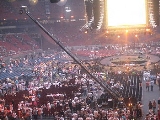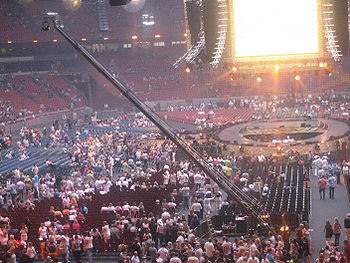
Crane shot
Encyclopedia

Filmmaking
Filmmaking is the process of making a film, from an initial story, idea, or commission, through scriptwriting, casting, shooting, directing, editing, and screening the finished product before an audience that may result in a theatrical release or television program...
and video production
Video production
Video production is videography, the process of capturing moving images on electronic media even streaming media. The term includes methods of production and post-production...
a crane shot is a shot taken by a camera on a crane. The most obvious uses are to view the actors from above or to move up and away from them, a common way of ending a movie. Some filmmakers like to have the camera on a boom arm just to make it easier to move around between ordinary set-ups. Most cranes accommodate both the camera and an operator, but some can be operated by remote control. They are usually, but not always, found in what are supposed to be emotional or suspenseful scenes. One example of this technique is the shots taken by remote cranes in the car-chase sequence of To Live and Die in L.A..
During the last few years, camera cranes have been miniaturized and costs have dropped so dramatically that most aspiring film makers have access to these tools. What was once a "Hollywood" effect is now available for under $400.
Types of crane shots
- Rise Up. The camera rises vertically.
- Fall Down. The camera moves vertically downward.
Famous crane camera shots
- The WesternWestern (genre)The Western is a genre of various visual arts, such as film, television, radio, literature, painting and others. Westerns are devoted to telling stories set primarily in the latter half of the 19th century in the American Old West, hence the name. Some Westerns are set as early as the Battle of...
High Noon had a famous crane shot. The shot backs up and raises, in order to see Marshal Will KaneWill KaneWill Kane is a fictional character and the main hero of the famous film, High Noon. He is played by Gary Cooper in the 1952 film, by Lee Majors in a made-for-TV sequel, High Noon, Part II: The Return of Will Kane , and by Tom Skerritt in 2000's High Noon, which was entirely re-worked for cable...
totally alone and isolated on the street. - The television comedy Second City TelevisionSecond City TelevisionSecond City Television is a Canadian television sketch comedy show offshoot from Toronto's The Second City troupe that ran between 1976 and 1984.- Premise :...
(SCTV) uses the concept of the crane shot as comedic material. After using a crane shot in one of the first NBC-produced episodes, the network complained about the exorbitant cost of renting the crane. SCTV writers responded by making the "crane shot" a ubiquitous symbol of production excess while also lampooning network executives who care nothing about artistic vision and everything for the bottom line. At the end of the second season, an inebriated Johnny LaRue is given his very own crane by Santa Claus, implying he would be able to have a crane shot whenever he wanted it. - Jean-Luc GodardJean-Luc GodardJean-Luc Godard is a French-Swiss film director, screenwriter and film critic. He is often identified with the 1960s French film movement, French Nouvelle Vague, or "New Wave"....
, in his film Sympathy for the DevilSympathy for the Devil (film)Sympathy for the Devil is a 1968 film shot mostly in color by director Jean-Luc Godard.- Plot summary :...
, used a crane for almost every shot in the movie, giving each scene a 360 degree tour of the tableau Godard presented to the viewer. In the final scene he even shows, on camera, the crane he was able to rent with his budget by including it in the scene somewhat. This was one of his traits as a filmmaker - showing off his budget - as he did with Brigitte Bardot in Le Mepris (Contempt). - Director Dennis DuganDennis DuganDennis Dugan is an American director, comedian, and actor. He is most famous for his partnership with comedic actor Adam Sandler, with whom he directed the films Happy Gilmore, Big Daddy, I Now Pronounce You Chuck and Larry, You Don't Mess with the Zohan, Grown Ups, Just Go With It, and Jack and...
frequently uses top-to-bottom crane shots in his comedy films. - Orson WellesOrson WellesGeorge Orson Welles , best known as Orson Welles, was an American film director, actor, theatre director, screenwriter, and producer, who worked extensively in film, theatre, television and radio...
used a crane camera during the iconic opening of Touch of EvilTouch of EvilTouch of Evil is a 1958 American crime thriller film, written, directed by, and co-starring Orson Welles. The screenplay was loosely based on the novel Badge of Evil by Whit Masterson...
. The camera perched on a Chapman crane begins on a close-up of a ticking time bomb and ends three-plus minutes later with a blinding explosion. - The closing take of Richard AttenboroughRichard AttenboroughRichard Samuel Attenborough, Baron Attenborough , CBE is a British actor, director, producer and entrepreneur. As director and producer he won two Academy Awards for the 1982 film Gandhi...
's film version of Oh! What a Lovely WarOh! What a Lovely WarOh! What a Lovely War is a musical film based on the stage musical Oh, What a Lovely War! originated by Charles Chilton as a radio play, The Long Long Trail in December 1961, and transferred to stage by Gerry Raffles in partnership with Joan Littlewood and her Theatre Workshop created in 1963,...
which begins on a single war graveWar graveA war grave is a burial place for soldiers or civilians who died during military campaigns or operations. The term does not only apply to graves: ships sunk during wartime are often considered to be war graves, as are military aircraft that crash into water...
, gradually pulling backward to reveal hundreds of identical crosses.

